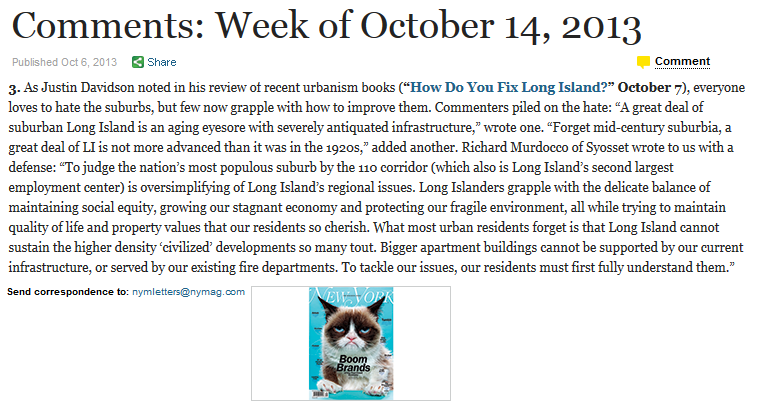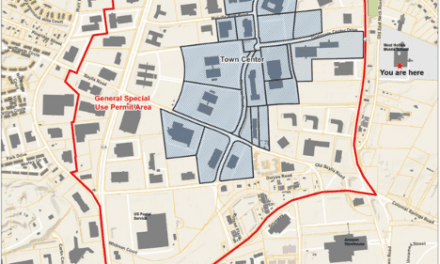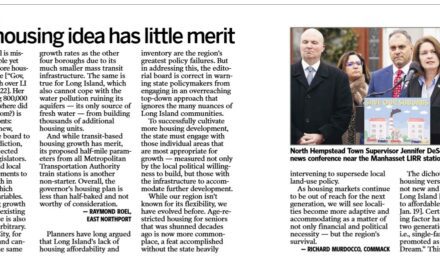In the October 7th issue of New York Magazine, Justin Davidson wrote a piece entitled “How Do You Fix Long Island?“. The work prompted me to pen the following response piece, which was published in the October 14th edition of the magazine:
The response in full is below:
Hello,
My name is Richard Murdocco, and I writing regarding Justin Davidson’s piece “How Do You Fix Long Island”. I write regularly on Long Island’s land use issues weekly for Long Island Business News and my work has appeared in Newsday as well. I have my BA from Fordham University, where I studied political science and Urban Studies, and MA from SUNY Stony Brook, where I studied land use planning with Dr. Koppelman, Long Island’s veteran planner. I have worked in the New York City Mayor’s office, as well as suburban environmental and housing nonprofits. I am a lifelong Long Islander who grew up in Suffolk County, and now lives in Nassau with my fiancée.
Davidson’s piece was very well-written, but I am surprised given the author’s impressive resume, the lack of nuance employed in his discussion of Long Island’s land use patterns.
To judge the nation’s most populous suburb by the 110 corridor (which also is Long Island’s second largest employment center) is over-simplifying of Long Island’s regional issues. As Davidson knows, Long Islanders grapple with the delicate balance of maintaining social equity, growing our stagnant economy and protecting our fragile environment, all while trying to maintain quality of life and property values that our residents so cherish.
In planning circles, New Urbanism has been gaining traction, and in most applications, the walkable downtown, higher density development is a solution to some problems, but not all. What most urban residents forget is that Long Island cannot sustain the higher density “civilized” developments so many tout. The problem is not the population itself, but rather, what to do with all of the wastewater that is the byproduct of growth. Our aquifers are federally designated as the sole-source for our drinking water. Our land use directly impacts our potable water. Unless we find a perfect solution to our wastewater woes, building up will just add further problems down the road.
Davidson writes:
Tools do exist. Route 110, which connects two old-timey towns on the North and South Shores, is dense and varied enough to support more urbanity: express bus lanes with sheltered stops or light rail connecting train stations, protected bike paths, sidewalks, bigger apartment buildings, commercial buildings pushed up to the roadside, with parking out back instead of in front, the spaces between chains and office fortresses filled in with smaller businesses. But ask most brand-name architecture firms about this kind of project and you get a smirk, a shrug, or a puzzled stare.
Davidson should know why these firms give a puzzled stare. The efforts to ramp up Long Island’s north-south transit access were studied extensively and in the end, killed due to lack of demand. Ridership on the LIRR is relatively steady despite explosive population growth. Further, express bus lanes are being created and sidewalks are being retrofitted with bike lanes. Most villages on the Island that are properly planned have parking in the back. Bigger apartment buildings cannot be supported by our current infrastructure, or served by our existing fire departments.
To tackle our issues, our residents must first fully understand them.
Thank you,
Richard Murdocco
Syosset, NY
Many thanks to Justin Davidson for prompting me to write my response piece, and for the magazine’s publication of it.














